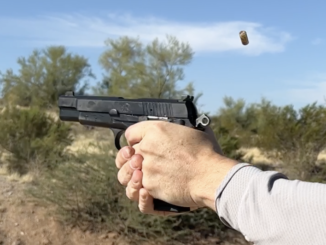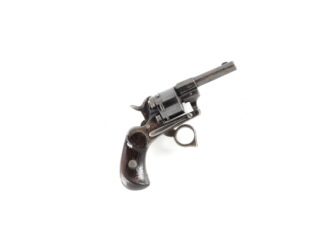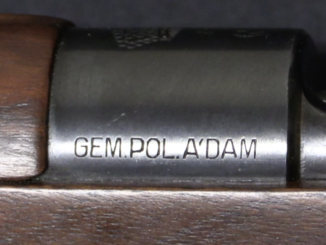This rifle is lot #410 in the upcoming May 2019 Rock Island auction.
When the Belgian military decided to adopt a new rifle in the late 1880s, they attached a wide variety of competitors. The best of the batch were Mauser and Mannlicher, with Mauser ultimately winning – but among the other entrants was Belgian Captain Uldarique Marga and his bolt action rifle design. Marga’s rifle used a Beaumont-style V-spring for the firing pin, 10 rear locking lugs, a single-stack blind magazine, and included a cartridge cutoff. It was an acceptable rifle, if not excellent (the V-spring Beaumont system was less reliable and durable than coil springs, and the rear locking lugs were an artifact of the recent black powder days) – but it simply did not show the excellence of the Mauser rifle.




and the rear locking lugs were an artifact of the recent black powder days) – but
Oh dear, I do hope that the whig theory of history (that history innevitably develops from worse to better, that its course is necessarily onwards upwards and towards the light), isn’t infectious.
If rear locking really was something that historical processes / the material productive forces / geist had left behind
Then what about front locking Lebels and Berthiers, being superseded by the rear locking MAS 36?
What about the totally smokeless powder Lewis gun, The BAR and it’s descendants, The Browning M1, and M2, and Steyr going from the G1888 inspired front locking Mannlicher Schaunauer bolt action, to the more Vetterli-like rear locking “Steyr Mannlicher” in the 1960s?
Design features might be fashionable at a certain time, like cars with tail fins and forward sloping grilles, or flared trousers…
But the solution to an engineering design problem is not necessarily attached to a certain historical period.
Sorry to be so pedantic
The gun literature is absolutely infested with whig theorists, and as a result, a great deal of human actions and interactions are completely ignored.
One of the few exceptions to the whig disease, was Ezell, for example in “the Great Rifle Controversy”
“(…)Lewis gun, The BAR and it’s descendants, The Browning M1, and M2(…)”
What is Browning M1?
Also, now I am completely confused: we are talking about (choose exactly one):
4-movement bolt-action repeating rifles
machine guns
If first: for example of positively-smokeless “rearward locking” see Steyr SSG 69
https://modernfirearms.net/en/sniper-rifles/standart-caliber-rifles/austria-standart-caliber-rifles/steyr-ssg-69-eng/
with over 40 years of production and being employing by numerous users, it must do its intended tasks well.
When the operating system begins to correlate with where the locking surfaces are located on the bolt or breech block.
And,
When the OP (Ian) is specific about the operating system, for example; “in rifle calibre machine guns, ‘blah’ location of the locking lugs surfaces was…”
Then, I might be specific.
Until those conditions are satisfied, then, no. No offence intended, just no.
The blanket statement that is so often seen in American literature that positioning locking surfaces further back on the bolt, is somehow “weak” or “obsolete” is at best an unsupported assertion, or, more usually, falling foul of the logical fallacies of “appeal to current practice” or “appeal to novelty”
Plus, in some of the examples that I cited, the assertion is also contradicted by actual practice.
Far too much of the English language literature on guns, is contaminated and perverted by authors who were engineering illiterates, and who took the ignorant requirements stipulated by some, at best, equally ignorant, or at worst, thoroughly corrupt committee members,
as gospel truth.
Or even worse, who wrapped themselves in a flag, and unquestioningly drank the q-laid of wartime propaganda.
I’ll give you an example that I’m still working on, both have locking lugs in frontof the magazine;
Which action is stronger in absolute terms, and why?
Carcano 1891?
Weatherby Mk5 Magnum?
I haven’t actually reached an answer yet. The supposedly weak action from a supposedly vastly inferior race to the WASPs, is actually very similar in strength parameters to the action that was marketed in America as “the strongest action in the world”.
But that isn’t the answer that the chauvinistic, nationalistic, and generally BS literature would give you.
I’m probably in a very argumentative frame of mind atm, but that doesn’t detract from the point that putting the locking surfaces on the back of a bolt, whatever the operating system, is not a somehow obsolete idea.
“(…)wrapped themselves in a flag(…)”
In case if you encounter individual boasting that U.S. rifles best rifles AND that rear-locking bad. Then ask about Savage Model 40:
http://ataleoftwothirties.com/?p=472
Along line How is that possible competent U.S. fire-arm manufacturer decided to use rear-locking lugs in 7,62×63 mm rifle?
One could also see the reapparence of rear locking lugs in the smokeless era as a progression from a mere workaround for black powder fouling to a design decision chosen for its own technical merits.
The Browning M1. Is that like the Browning M1919
but without all those other numbers? Sorry to be so pedantic.
Uldarique Marga, Lt. of infantry residing at 57 Rue St.Georges, Brussells, in the Kingdom of Belgium applied for a patent in the United States for his novel invention on 27 Jan. 1892 and received Patent No. 515,348 “U. Marga. Magazine bolt gun” on 27 Feb. 1894. He described his magazine thusly:
10 “The repeating or magazine fire-arm which forms the subject of my said invention belongs to that class in which the charge, ordinarily consisting of five cartridges is rapidly renewed by introducing into the breech from (15) above, a loader containing five cartridges which, as they descend in the magazine provided on the under side of the breech, depress an elevator which automatically moves a cartridge into the breech at each operation of the breech bolt. …”
Pretty nifty! Too bad about the Beaumont V-spring weakness in the bolt handle. Other people have noted that the French reverted to massive rear-locking bolt lugs on the otherwise Arisaka-esque bolt of the MAS Mle. 1936 rifle due to attempts to shorten the receiver and shorten the bolt throw, as well as appraisals of the effects of Flanders mud on bolt action operating mechanisms and the effort required to clear them. Some Mannlicher-Shönauer type actions also used rear mounted locking lugs. Of course, the Swiss started the M1889 compressed black-powder Schmidt-Rubin rifle series with very long receivers and rear locking lugs like the Vetterli, then by 1911 went to mid-mounted locking lugs, and by 1931, for the final iteration of the Schmidt-Rubin straight-pull bolt action rifle had shortened the bolt and receiver and moved the locking lugs to the front.
I used to do a lot of patent research for C&Rsenal, and came across a number of interesting finds in my studies.
To the best of my knowledge (and we can never know completely for sure), the stripper clip was invented by Louis P. Diss, a close colleague of James Paris Lee, who filed a patent (US356,276) for it in 1886, a year after Mannlicher invented the en-bloc clip. Diss’ clip even kind of looks like it might have come out of an accident involving a handmade copy of an en-bloc clip that was made too soft, and so whose feed lips yielded upon attempting to insert the clip — although that’s purely a guess on my part.
While it’s hard to prove who invented the stripper clip first, it’s easy to prove that Paul Mauser definitely didn’t. His first patent for a stripper clip was filed in December 31st, 1888 (US402,605). Even the Mosin-Nagant style clip invented by the Nagant Brothers came earlier, on December 10th of the same year (BE84,225).
That said, Paul Mauser certainly did invent the modern-style stripper clip we are so familiar with, with a refinement in 1892 (DE65,644) and reaching its final form in 1894 (US547,392).
@Matthew
Many thanks
🙂
I’ve never delved deeply into patents for strippers. It doesn’t help that a big bunch of 19th century British patents are not online.
As explanation for any readers who are not deeply into Patents, and who are probably wondering why an irrelevant bunch of islands that’s population apparently cannot even laugh at the EUSSR, and just walk away, have even the slightest significance for technological patents…
Britain was the largest economy up to about 1925, and the British patent orifice would only issue a patent if the applicant (not necessarily the first person who thought of the idea) applied for a British patent first.
If they’d patented the idea somewhere else first, tough luck for them!
If you can point me to some, I would be interested in reading some materials on the development of the stripper clip in British service. I’ve been able to find almost nothing on the matter…even C&Rsenal’s episode on the Lee-Enfield seems to just note a vague period of time at which the concept appears fully-formed and nothing about the development.
Interesting to learn about those issues with British patents…between that and the difficulty of searching them, it would explain why I so rarely found British patents for anything I looked for, except in references in other patents.
That said, the UK then and now is still miles ahead of Belgium. Belgium doesn’t have any patents from before the 1980’s digitized, and in the 1880’s and 1890’s they accepted handwritten cursive patents instead of requiring typewritten ones.
You have a nice job, I like America because you can buy a gun and shoot some pedal what will get you into the field
Despite his lack of success Marga seems to have had some supporters in the world of arms journalism. This from a report in 1893:
“The Echo de “l’Armee tells us that the rifle is superior to every system adopted…Mannlicher, Mauser, Lebel, Vetterli – these are now arms behind the times”.
Brilliant!
Confirmation that there have always been gunzine journos for sale.
As I can see, there is some argumentation about positives or negatives thereof, pertaining where locking surfaces on rifle with rotating bolt are located. In all sincerity, I do not see any disadvantage, or less of modernity in locking surfaces being behind the magazine (closer to operator).
It may look as inappropriate from static/ stress loading point of view, but this point is largely immaterial since receiver is typically out of a solid, continuous piece of metal in its entire length.
Where is a great advantage with this arrangement though is in the fact, that during unloading/ proofing the operator can very clearly see status of chamber. The other is that during cleaning procedure, there is an unobstructed view of chamber which otherwise in Mauser type of action does not exist.
“Mauser”
Interestingly Mauser firm also during its history produced rear locking 4-movement bolt-action repeating rifle namely Mauser 77: https://revivaler.com/the-mauser-77/